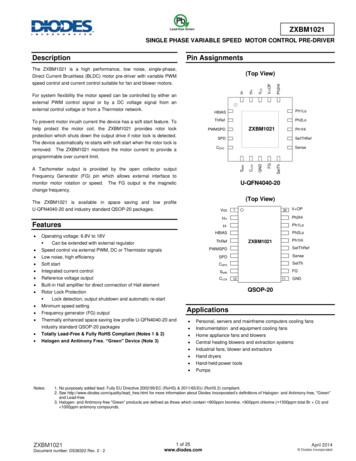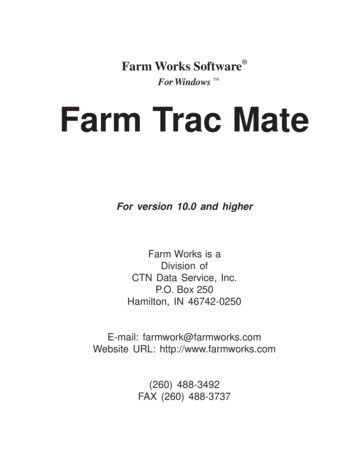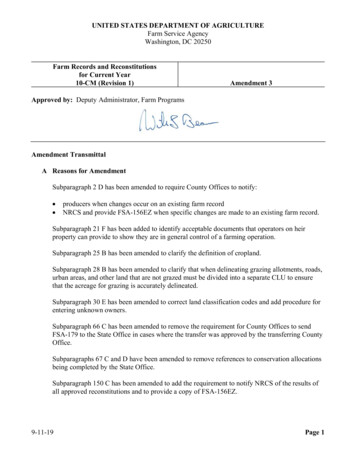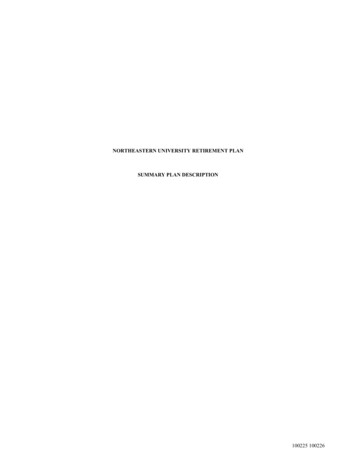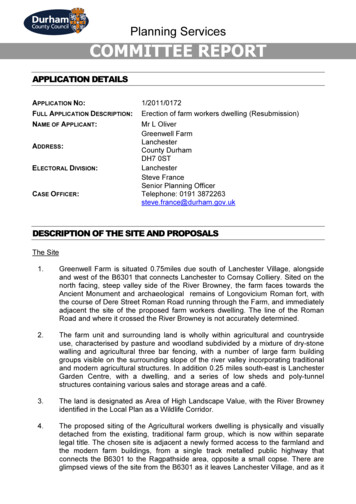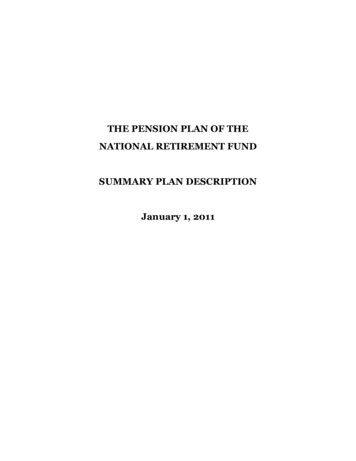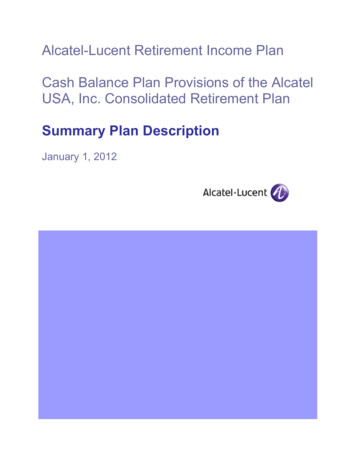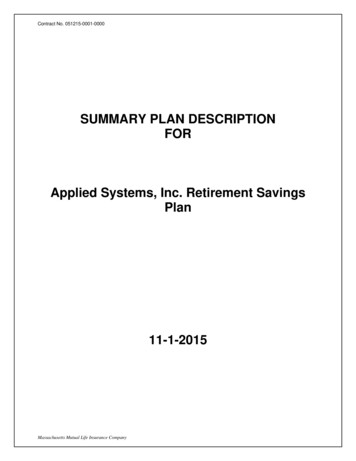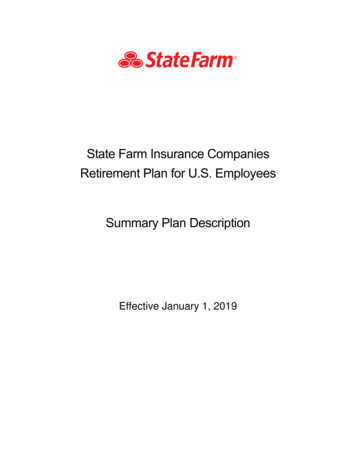
Transcription
State Farm Insurance CompaniesRetirement Plan for U.S. EmployeesSummary Plan DescriptionEffective January 1, 2019
Retirement Plan for U.S. EmployeesSummary Plan DescriptionTable of ContentsIntroduction . 4Eligibility. 4Who Is Eligible . 4Enrollment . 5Plan Membership. 5Vested Interest . 5Other Service . 5Changes in Employment Status. 6Gap in Employment . 6Benefits. 7Benefit Formula . 7Compensation . 7Average Annual Compensation . 9Covered Compensation .10Credited Service .10When Benefits Begin . 12Electing Retirement .12Early Retirement Benefits .12Normal Retirement Date .13Deferred Retirement Benefits .13Required Minimum Distribution Date .13Distributions . 13Retirement Income Options .13Value of Benefit 5,000 or Less .15Disability Benefits . 16Disability Benefit Options .16Survivor Benefits. 18Beneficiary.18Amount of Survivor Benefit .18Claims and Appeals Procedures . 19Claims Procedures .19Denial of a Claim .19How to Appeal a Denied Claim .20Review of Claim Appeals .202
Retirement Plan for U.S. EmployeesSummary Plan DescriptionAdministrative Information . 21Official Plan Document .21Modification or Termination of the Plan.21Rules and Regulations.21Benefit Adjustment .21Statements .22Benefits Payable to Incompetents .22Top Heavy Provisions .22Benefits Insured.22Additional Information .23Summary Plan Description . 24Your Rights under ERISA .26Appendix A: Retirement Plan Calculation Tables . 282019 Covered Compensation Table .28Appendix B: Income Option Adjustments . 30Option B – Life Income with 10 Years Certain .30Option C – Joint Life with 75% to Survivor .30Option D – Life income with 50% to Beneficiary .333
Retirement Plan for U.S. EmployeesSummary Plan DescriptionIntroductionThe State Farm Insurance Companies Retirement Plan for United States Employees (“Plan” or“Retirement Plan”) provides a defined pension benefit to eligible employees, based on the planterms and the Employee’s years of credited service and compensation. State Farm pays the fullcost of this plan. The Plan constitutes a pension benefit plan under the Employee RetirementIncome Security Act of 1974, as amended ("ERISA").This Summary Plan Description presents in condensed form the main features of theRetirement Plan as of the stated date. Please note the terms of the Retirement Plan have beenamended through the years and that the prior provisions control for those respective years. Thissummary is provided for information purposes only and is not a contract of employment. It doesnot cover all provisions, limitations, and exclusions.In the case of a conflict between the information presented here and the plan, the terms of theapplicable plan shall govern. A complete copy of the Retirement Plan may be obtained from theState Farm Benefits Center.EligibilityWho Is EligibleEligible Active EmployeesYou are eligible to become a participant in the Plan if, based on the payroll records of StateFarm Mutual Automobile Insurance Company (“State Farm” or the “Company”), you areemployed by State Farm (or one of the participating Companies).Who Is Not EligibleYou are not eligible for coverage under the Plan and are excluded from participation if you fitany of the following descriptions, even in the instance where a court or administrative agencydetermines you are a common law employee: Any director (unless otherwise employed by the Companies); Any person whose terms and conditions of employment are determined by a collectivebargaining agreement between the Companies and a labor union which does not makethe Plan applicable to them; Any person holding a State Farm Agent’s Agreement with any of the Companies or anyemployee of such person; Any individual performing services for the Companies who is classified as an externalassociate per the Companies’ records, including but not limited to any external claimresource, any external resource of any kind, any contingent worker, any leasedemployee or any person otherwise operating or performing under a service provideragreement. The term “leased employee” means an individual who is a “leasedemployee” within the meaning of Section 414(n)(2) of the Internal Revenue Code and4
Retirement Plan for U.S. EmployeesSummary Plan Descriptionany other person who provides services to the Companies pursuant to an agreementbetween the Companies and a leasing organization or similar organization; or Any Employee operating under a Staff Assistance Agreement.EnrollmentThere is no enrollment process. Eligible employees (“Employees”) automatically become activeplan members and have a vested benefit upon satisfaction of the below rules.If employment ends before the Employee vests, all pension benefits are forfeited at termination.Plan MembershipAn Employee becomes an active member in the Plan on the day the Employee completes oneyear of service or attains age 21 (if later).Year of service means 365 days of State Farm service. Day of service means each daybeginning with the first day of employment and ending on the date of termination. This does notinclude gaps in employment of more than 365 days, but includes gaps of shorter duration.If you terminate your employment after becoming a Plan member, you will no longer be anactive member. However, if you are reemployed as an Employee, you will automatically becomean active member on your date of reemployment.Vested InterestIn GeneralHaving a vested interest means you have a non-forfeitable right to your retirement income andpre-retirement survivor benefit, based on the retirement income you have accrued as of youreffective date of benefit. An active member has a vested interest on the earlier of: The date that he or she completes five years of service after age 18; or The day that he or she attains age 65 with at least one year of service.Other ServiceService in the following positions is counted for purposes of Plan Membership and Vesting, butnot for purposes of Credited Service: Former Employee of Trainee Agent or Agency Manager; Trainee Agent prior to October 1, 1995; Former Employee of BlueOwl LLC or HiRoad Assurance Company; or Any person who is not a State Farm employee but who provides services to State Farmif:oSuch services are provided pursuant to an agreement between the State Farmand another organization; and5
Retirement Plan for U.S. EmployeesSummary Plan DescriptionoThe work was performed under the primary direction and control of State Farm(what was done and how it was done); andoSuch person has performed such services to State Farm on a substantially fulltime basis (at least 1,500 hours of service) during any consecutive 12-monthperiod. (Must have hours worked in each month of that 12-month period).Employees must provide the Plan Administrator with required documentation.Changes in Employment StatusGap in EmploymentIf you terminate employment and are subsequently reemployed, time during your period ofseparation of employment: Counts as service for Plan membership and vesting, if your period of separation is 365days or less. Does not count as service for Plan membership and vesting, if your period of separationexceeds 365 days. Does not count as Credited Service used to determine the amount of your benefit. Does not count as Credited Service used to determine your eligibility for a disabilitybenefit.In the event that the period of separation from employment is a maternity or paternity absence,the number "365" for the period of separation referenced above is replaced by the number"730".Effect on Previously Accrued BenefitsIf you previously left employment before vesting and are rehired by the Companies, the CreditedService you forfeited and the Normal Annual Retirement Income based on that Credited Servicewill be reinstated on your date of rehire.If you received a cash out (the value of your benefit at prior termination was 5,000 or less): In general, the Credited Service you forfeited and the Normal Annual Retirement Incomebased on that Credited Service will generally not be reinstated on your date of rehire. If the cash-out was more than two years after the year in which you terminated, yourCredited Service will be reinstated but there will be an offset for the lump sumdistribution you previously received.If you have a vested accrued benefit that was not cashed out, any future Credited Service willbe added to the previous Credited Service.Effect on Those Receiving PaymentsIf you are rehired from a retired status (i.e., you are receiving regular retirement distributions),the impact to your benefits under the Plan depends on how you are employed:6
Retirement Plan for U.S. EmployeesSummary Plan Description If you are re-employed on a part-time basis, your benefit payments under the Plan willcontinue. If you are re-employed on a full-time basis, your distributions will stop. If you are re-employed within 90 days of your Effective Date of Retirement, on a full-timeor part-time basis, you will be treated as though you never retired. You will be asked torepay any benefit payments made and no further benefit payments will be made untilyour subsequent retirement date.Employees working on a part-time basis and the employees working on a full-time basis mayaccrue additional benefits to the extent permitted under the Plan. At the full-time employee’snew retirement date or the part-time employee’s termination of employment, the benefitcalculated will be reduced by the actuarial equivalent of any payments made to the employeewhile he or she was retired. Such benefit will not be reduced below the benefit calculated priorto the member’s reemployment, determined under life income option basis.If you are eligible for an increase upon subsequent termination from part-time employment, youare eligible for a new retirement election on the additional accrued benefit.BenefitsThe Company makes all contributions to the Plan; Employees do not make any contributions.The benefit provided under the Plan is based on the Benefit Formula. While the formulacalculates the benefit to be paid as a life income (Option A below) at age 65, there is noreduction for benefits beginning after age 62. Reduced benefits are available as early as age55.The formula contains a number of defined terms. These terms are defined below. There areexamples after the defined terms.Benefit FormulaGenerally, your Normal Annual Retirement Income is: 1.3% of the portion of your Average Annual Compensation up to your CoveredCompensation multiplied by years of Credited Service up to 35; and 1.75% of the portion of your Average Annual Compensation that is in excess of yourCovered Compensation multiplied by years of Credited Service up to 35 years.Normal Annual Retirement IncomeNormal Annual Retirement Income is the annual benefit as determined under the Life Incomedistribution option.CompensationCompensation generally means Form W-2, Box 1 Wages for the current year, increased byelective contributions to the Flexible Compensation Plan and the 401(k) Savings Plan, andreduced by the following items, if these items were included in wages:7
Retirement Plan for U.S. EmployeesSummary Plan Description Reimbursements or other expense allowances; Fringe benefits (including but not limited to trips and merchandise awards); Moving expenses; Deferred compensation; Welfare benefits; Settlement payments; Incentive awards that are paid early due to termination or retirement; Incentive awards that are based on a multiple-year performance measure other thanpayment for up to 850 units in the Long Term Incentive Plan (LTIP); and Pay for unused or accrued time-off benefits*.*The reduction for the payout of unused or accrued time-off benefits does not apply to memberswho are part of the grandfathered group described below. Those who meet all of the followingcriteria may have up to 123 days of time-off benefits counted in Compensation: On December 31, 2006, the member was at least age 50; On December 31, 2006, the member was either an active Employee or an active agentoperating under a State Farm Agent’s Agreement; Since December 31, 2006, the member has worked continuously with the Companies asan Employee or agent; Since December 31, 2006, the member has not received a prior payment of unused oraccrued time-off benefits due to termination of employment or movement from full-timeto part-time employment; and At the time of retirement, the member is not a participant in the Long Term IncentivePlan.Compensation is subject to an annual Internal Revenue Code compensation ensation Limit 245,000 250,000 255,000 260,000 265,000 265,000 270,000 275,000 280,000Examples – CompensationThe following provides examples of specific types of dollars that are included or not included asCompensation for Retirement Plan purposes. This list is not an all-inclusive list.8
Retirement Plan for U.S. EmployeesSummary Plan Description Included: Regular pay, 401(k) Savings Plan contributions, Flexible Compensation Plancontributions, overtime, shift differential, enterprise incentive plan, past performancecash, catastrophic differential pay, recognition bonuses, and most other monetaryincentive payments. Not Included: Reimbursements (such as for textbook fees), expense allowances (suchas spouse's travel expenses), fringe benefits (such as education awards, anniversarygifts), moving expenses (such as relocation allowances and marketing incentivebonuses), deferred compensation, settlement payments, welfare benefits (such asseverance pay) and pay for unused on accrued time off benefits (unless grandfathered).Average Annual CompensationAverage Annual Compensation is calculated by first determining the period during which themember’s annual Compensation amounts for any 1,825 consecutive days of Credited Service isthe highest. Once the period is determined, Average Annual Compensation is calculated byaveraging, over such period, the sum of the member’s Compensation less incentive awards andthe highest 5 consecutive incentive awards paid in the years counted in the 1,825-day period.Example – Average Annual Compensation CalculationParticipation Date: May 1, 1984Termination Date: July 31, 2019 (Age 62 with 35 years of credited service)Pensionable Earnings:Plan Year2014*20152016201720182019*Base 47,000 50,000 52,000 54,000 56,000 35,000Incentive 4,000 5,000 5,500 4,200 5,300 6,000Total 51,000 55,000 57,500 58,200 61,300 41,000*Portion of the year counted in the highest 1,825 consecutive days. Step 1: Determine the period during which the highest Annual Compensation for any1825 consecutive days of credited service is paid. Compensation for any day is basicallythe annual Compensation amount divided by the number of days of credited service inthe year. In this example, the period that will be used is August 1, 2014 through July 31,2019.The calculation uses a rolling 1,825 days so in the example above the calculation isrolling backwards from July 31, 2019, using 212 days of 2019 and 153 days of 2014. Step 2: Taking the same period of credited service used in Step 1, calculate AverageAnnual Compensation based on just base pay. In the above example, this result wouldbe: (( 47,000 x 153 / 365) 50,000 52,000 54,000 56,000 35,000) / 5 53,340. Step 3: The highest Annual Compensation for any 1825 consecutive days of creditedservice was paid in the calendar years 2014 through 2019.9
Retirement Plan for U.S. EmployeesSummary Plan Description Step 4: Sum the 5 highest consecutive years of incentive awards within the calendaryears determined in Step 3 and divide by this result by the number of years of creditedservice. In the above example, the result would be ( 5,000 5,500 4,200 5,300 6,000) / 5, 5,200. Step 5: Add the results from Steps 2 and 4 to determine the member's Average AnnualCompensation at termination.The member’s Average Annual Compensation would be 58,540. This amount is used in thebenefit formula.Covered CompensationCovered Compensation is the average of the Social Security taxable wage bases in effect foreach year in the 35-year period ending with the calendar year in which you attain your SocialSecurity retirement age defined as follows:Year of BirthBefore 1938Between 1938 – 1954After 1954Social Security Retirement Age656667See Appendix A: Retirement Plan Calculation Tables for the Covered Compensation table.Credited ServiceYour credited service is your time in the Plan. It is the amount of time used in calculating yourbenefits. The maximum credited service you can have in the Plan is 35 years. Full-time: An active member employed full-time shall receive a day of credited servicefor each day of Plan membership in the year. If an active member is on paid sick leave,that time will be counted as credited service (but only up to one year). Part-time: An active member employed part-time throughout the plan year shall receive:o365 days of Credited Service for the Plan year, if the employee receivescompensation for 900 hours or more of service in the Plan year, oroNo Credited Service for the Plan year if the employee receives compensation forless than 900 hours of service in the Plan year.Transfer between Full-Time and Part-TimeAn active member who transfers between full-time and part-time employment during a PlanYear shall receive Credited Service as follows: Full-time to part-time: For any month (or portion thereof) the member is employed fulltime, the member is deemed to have 190 hours of service. These hours are added toactual part-time hours of service for which compensation was paid in the Plan year. If thetotal compensation paid is for 900 hours or more, the member receives 365 days ofCredited Service. If the total is less than 900 hours, the member receives CreditedService only for the days of full-time employment.10
Retirement Plan for U.S. EmployeesSummary Plan Description Part-time to full-time: If the member had received compensation in the Plan Year for900 hours of service at the time of the transfer to full-time, the member receives 365days of Credited Service for the Plan year. Otherwise, once the employee moves to fulltime, periods of part-time employment during the same Plan year will be treated as fulltime for Credited Service purposes.Example – Retirement Income CalculationAverage Annual Compensation is less than Covered CompensationFor a member born in 1957 and retires in 2019, at age 62:Calculation ComponentAverage Annual CompensationCovered Compensation1.3% of Average Annual CompensationYears of Credited ServiceNormal Annual Retirement IncomeNormal Monthly Retirement IncomeCalculation Amount / Outcome 90,000 96,0000.013 x 90,000 1,17035 years 1,170 x 35 40,950 40,950 / 12 3,412.50Average Annual Compensation exceeds Covered CompensationFor a member born in 1957 and retire in 2019, at age 62:Calculation ComponentAverage Annual CompensationCovered Compensation1.3% of Average Annual Compensation up tothe Covered Compensation LimitAverage Annual Compensation Less CoveredCompensation1.75% of Average Annual Compensation inexcess of the Covered Compensation LimitAdd calculated amountsYears of Credited ServiceNormal Annual Retirement IncomeNormal Monthly Retirement IncomeCalculation Amount / Outcome 100,000 96,0000.013 x 96,000 1,248.00 100,000 – 96,000 4,0000.0175 x 4,000 70.00 1,248.00 70.00 1,318.0035 years 1,318.00 x 35 46,130.00 46,130.00/12 3,844.1711
Retirement Plan for U.S. EmployeesSummary Plan DescriptionWhen Benefits BeginElecting RetirementA vested member may start benefits as early as the first day of the month following the later ofattaining age 55, termination of State Farm employment, or date of receipt of notice of intent toretire. This date shall be the member’s Effective Date of Retirement.If a vested member terminates employment prior to age 55 (or terminates employment after age55 and does not begin receiving retirement income), the member is eligible to receive reducedPlan benefits beginning at age 55 or unreduced retirement benefits beginning at age 62.A member must initiate the start of retirement benefits prior to the elected Effective Date ofRetirement. The member should communicate the date on which he or she plans to retire to theRecord Keeper once he or she is within 90 days of retirement.Contact the State Farm Benefits Center when you are ready to retire.Early Retirement BenefitsIf you have a vested interest, you may retire with a reduced benefit on the first day of any monthafter your 55th birthday and before your 62nd birthday. There is no reduction in the benefit dueto early retirement after age 62. The Normal Annual Retirement Income accrued on your earlyretirement date would be multiplied by an early retirement factor to account for receivingpayments prior to age 65.The Option A – Life Income early retirement factors are stated below.Age at Retirement5556575859606162636465Early Retirement If you are no longer employed by State Farm, your benefit under Life Income is the same at age62 and at age 65. If you delay commencement past age 62 you are losing those past payments.The monthly benefit amount will be further reduced based on the Income Option selected and ifapplicable the age of your joint annuitant or beneficiary.12
Retirement Plan for U.S. EmployeesSummary Plan DescriptionNormal Retirement DateYour Normal Retirement Date is the first day of the month following your 65th birthday. Forexample, if you reach age 65 on May 23, your Normal Retirement Date is June 1.Deferred Retirement BenefitsRetirement benefits are considered deferred if you retire after you attain age 65.If your Effective Date of Retirement is on or after April 1 following the year you attain 70 1/2, theamount of your Normal Annual Retirement Income will be actuarially adjusted to account for theperiod after age 70 1/2 in which you were not receiving any Plan benefits.Required Minimum Distribution DateThe required minimum distribution date for an inactive member is April 1 following the year youattain age 70 ½. Approximately 90 days prior to your required minimum distribution date you willreceive a reminder notice with information explaining your payment options. If you do not initiateretirement prior to your required minimum distribution date your retirement will be processed bydefault. If you are not legally married default will be based on the Life Income retirement option.If legally married default will be based on Life Income with 50% to Beneficiary.DistributionsThe Plan provides retirement benefits. However, if you become disabled and meet certaincriteria, you may be eligible for disability benefits under the Plan. Further, if you die prior toretirement, the Plan provides survivor benefits for your beneficiary.Please note, if the present value of your Plan benefit is 5,000 or less, the benefit will bedistributed in one sum.Retirement Income OptionsEarlier sections described how your retirement benefit is calculated and how the benefit isreduced if distributions begin between ages 55 and 62. This section explains the four differentRetirement Income Options choices that are available to you if the present value of your benefitis more than 5,000.The Retirement Income Options are: Option A – Life Income. Option B – Life Income with Ten Years Certain. Option C – Joint Life Income with 75% to Survivor. Option D – Life Income with 50% to Beneficiary.These are described in more detail below. Regardless of your election, your first retirementincome payment is scheduled to be made the first business day of the month following yourEffective Date of Retirement.13
Retirement Plan for U.S. EmployeesSummary Plan DescriptionPlease note, if you are married on your Effective Date of Retirement you must elect Option C orOption D with your spouse as the joint annuitant. To elect a different option or name someoneother than your spouse as the joint annuitant, your spouse must provide written consent.The preceding Example – Retirement Income Calculation showed you how to calculate yourretirement income under Option A if you were age 62 or older at retirement. If you select one ofthe other retirement income options, your monthly income will be different. Each option has thesame actuarial or relative value at the time benefits commence. This means the total amountexpected to be paid under each option, taking into account certain assumptions regardinginterest and mortality, is equal. Which option has the most value to you depends on how longyou and/or your joint annuitant/beneficiary (under Option C or Option D) continue to receivebenefits.On your Effective Date of Retirement, your retirement income option election becomesirrevocable. While you may cancel, revoke, or change your retirement income election at anytime prior to your Effective Date of Retirement, your election cannot be changed after yourEffective Date of Retirement.The Record Keeper will provide you wi
"Retirement Plan") provides a defined pension benefit to eligible employees, based on the plan terms and the Employee's years of credited service and compensation. State Farm pays the full cost of this plan. The Plan constitutes a pension benefit plan under the Employee Retirement Income Security Act of 1974, as amended ("ERISA").
